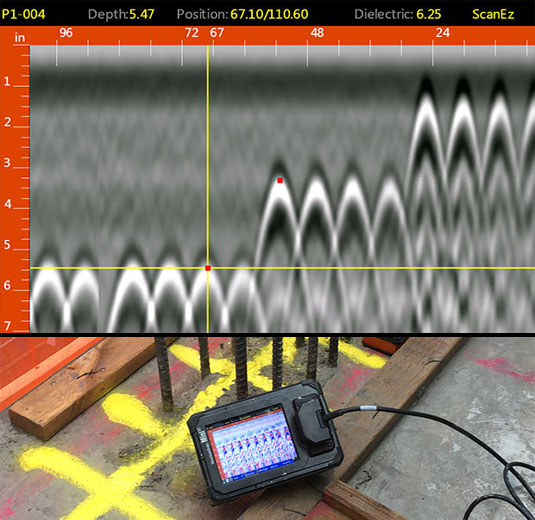Accuracy and Accuracy in Concrete Scanning Solutions
Accuracy and Accuracy in Concrete Scanning Solutions
Blog Article
Unveil the Transformative Power of Concrete Scanning in Making Best Use Of Effectiveness and Security
Concrete scanning has actually become a vital device in the building and construction industry, using unmatched benefits in boosting job performance and guaranteeing safety criteria. By making use of advanced modern technology, concrete scanning enables professionals to see beyond the surface area, uncovering covert intricacies that could impact the architectural honesty of a building. The transformative power of concrete scanning depends on its ability to supply comprehensive understandings and real-time data, changing how jobs are intended and carried out. As we explore the intricacies of this ingenious method, a globe of opportunities opens, showcasing a brand-new era of building methods that focus on accuracy and safety.
Value of Concrete Scanning
Making certain the architectural honesty and security of construction jobs begins with the critical step of performing extensive concrete scanning. Concrete scanning is a non-destructive approach used to find and map subsurface elements within concrete structures.
The relevance of concrete scanning can not be overstated, as it plays an essential role in protecting against accidents, decreasing project delays, and ensuring the long-lasting resilience of the building and construction. By recognizing potential threats before the construction phase begins, home builders can implement suitable precaution and make informed choices relating to the design and execution of the task. In addition, concrete scanning helps in enhancing project timelines and spending plan by avoiding unanticipated expenses and hold-ups that might emerge because of unexpected blockages within the concrete. Eventually, investing in comprehensive concrete scanning is a proactive method that enhances both performance and security in building and construction tasks.
Exactly How Concrete Scanning Works
Concrete scanning operates as a critical device in building tasks by utilizing innovative innovations to find and map subsurface elements without creating structural damages. Ground Penetrating Radar (GPR) and Electromagnetic Induction (EMI) are 2 primary approaches used in concrete scanning.
Throughout the scanning process, the information collected is examined in real-time, allowing prompt recognition of prospective risks or barriers below the surface. This information aids in decision-making, ensuring that building tasks proceed securely and efficiently. Furthermore, 3D imaging software program can be utilized to produce topographic maps of the subsurface components, further enhancing job preparation and execution. By utilizing these innovative technologies, concrete scanning dramatically reduces the threat of costly damages and injuries on building websites.
Benefits of Concrete Scanning
One of the key advantages of concrete scanning is the capability to find and situate embedded items such as rebar, post-tension wires, and avenues accurately. Concrete scanning helps in planning and designing extra efficiently, as it provides specific info concerning the place and deepness of architectural elements.

Case Research Studies: Concrete Scanning Success

In one more instance, a building and construction business made use of 3D concrete scanning to examine the condition of maturing concrete frameworks in a historical structure. The in-depth scans given beneficial understandings into the level of wear and tear and helped focus on maintenance initiatives successfully. By proactively attending to areas of worry determined with scanning, the business was able to extend the life expectancy of the framework and make certain occupant security.
These instance studies highlight the transformative power of concrete scanning in improving performance, accuracy, and security in building projects.
Implementing Concrete Scanning in Projects
Applying advanced scanning technologies during building tasks has actually become significantly vital for enhancing accuracy and safety and security. By integrating concrete scanning right look here into job preparation and implementation, building and construction groups can determine potential threats, such as rebar or post-tension cables, concealed within concrete frameworks. This proactive technique lessens the danger of crashes, delays, and costly rework, inevitably resulting in much more reliable task timelines and budget plans.
To execute concrete scanning properly, task managers should work together very closely with seasoned scanning professionals to determine the most ideal scanning strategies for the certain task demands. Involving scanning specialists from the very early phases of a job allows the team to develop extensive scanning strategies that deal with essential areas of worry and make see certain detailed data collection.
Moreover, integrating concrete scanning into routine project workflows can improve decision-making procedures, as real-time scan data gives immediate insights into the problem of concrete frameworks - Concrete Scanning. This data-driven technique promotes notified analytical and makes it possible for teams to make adjustments promptly, cultivating a society of efficiency and safety throughout the task lifecycle

Conclusion
Finally, concrete scanning plays a vital duty in enhancing efficiency and safety and security in building and construction projects. By using advanced technology to map and detect out underlying structures within concrete, this procedure aids to stop expensive errors, make sure architectural stability, and minimize dangers on website. With the ability to uncover concealed elements and supply exact data, concrete scanning confirms to be a useful tool for enhancing project outcomes and making the most of total success.
Concrete scanning is a non-destructive method made use of to spot and map subsurface elements within concrete structures. Additionally, concrete scanning assists in optimizing task timelines and budget by preventing unanticipated expenses and hold-ups that might develop due to unpredicted blockages within the concrete. One remarkable case study includes a large renovation job where concrete scanning played a critical function in guaranteeing task success.In an additional instance, a construction company used 3D concrete scanning to analyze the condition of maturing concrete frameworks in a historic building. By incorporating concrete scanning right into task preparation and implementation, construction groups can determine potential dangers, such as rebar or post-tension wires, concealed within concrete structures.
Report this page